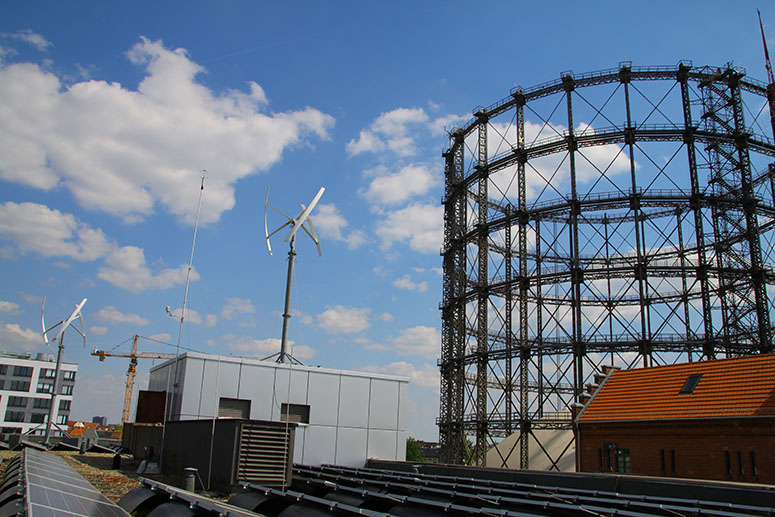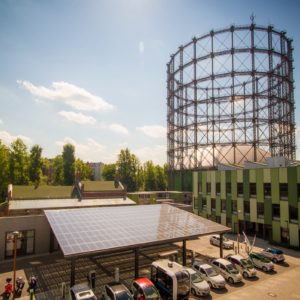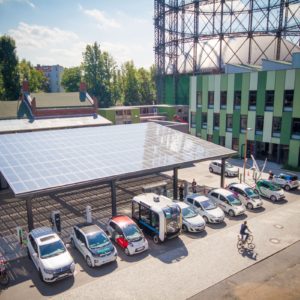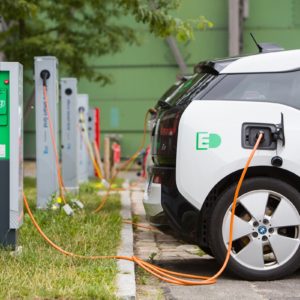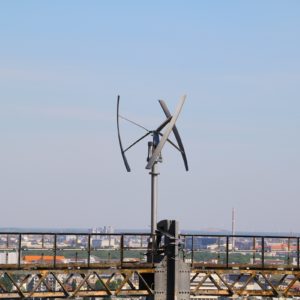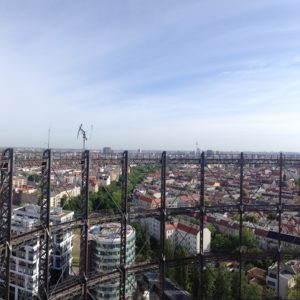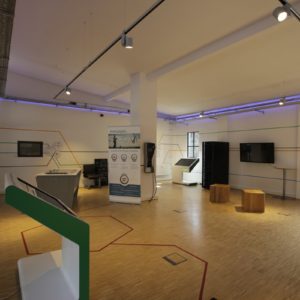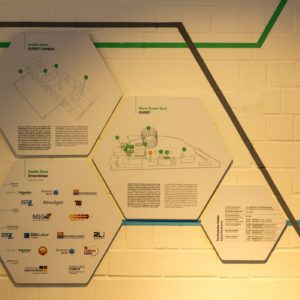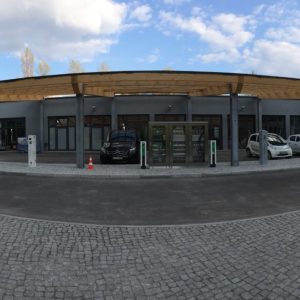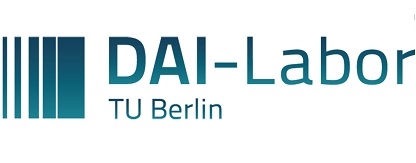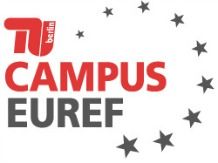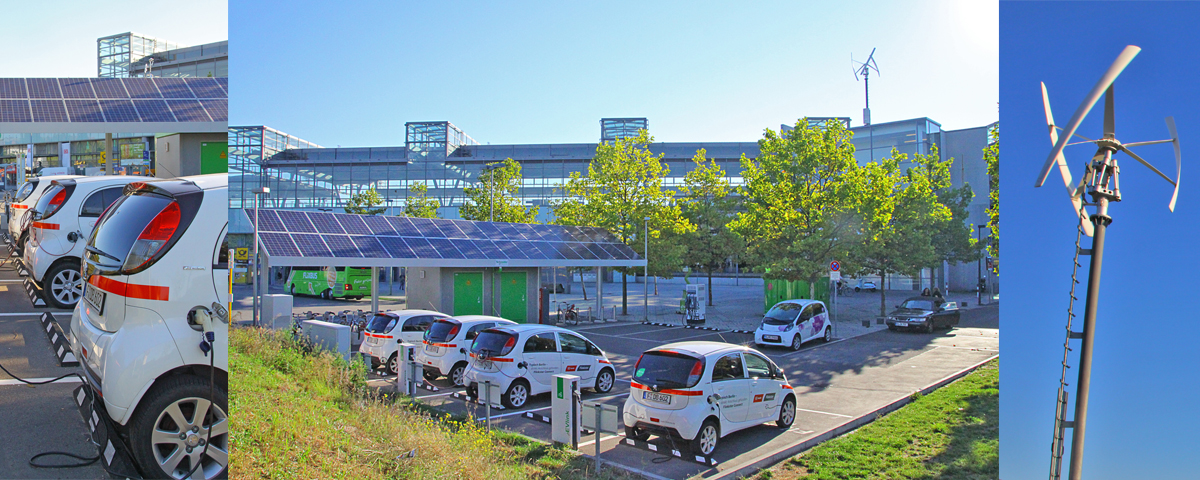
B2 – Intelligent Mobility Station: Train station Berlin Suedkreuz
1. September 2015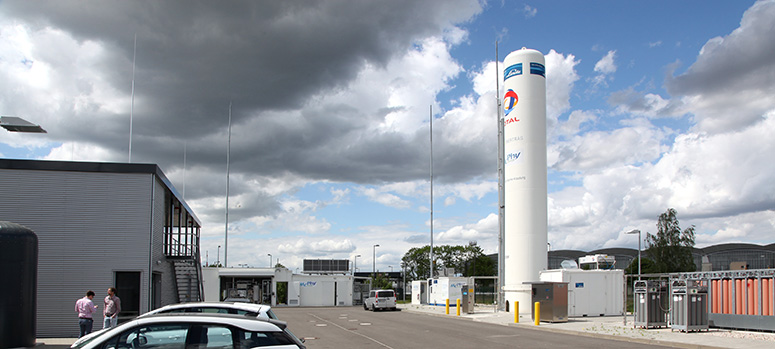
H2BER
1. September 2015D3 – Micro Smart Grid EUREF (Twinlab)

What will transportation look like in the future? Or more specifically: How can different modes of transportation be interconnected and provided with environmentally safe sources of energy? Furthermore, which new strategies, technologies, and processes will be necessary in order to do so?
The RLI was able to test this at the EUREF Campus in Berlin-Schöneberg. The campus is a model urban district in which sustainable housing, working, and mobility are interconnected in a closed area. As part of the funding program “Electric Mobility Showcase” of the Federal Government, the RLI installed a Micro Smart Grid (MSG) in the district, and developed this into a research and testing network. Within this network, different sources of energy and users as well as storage systems have been linked intelligently in a Micro Smart Grid (MSG). The network management ensured the economic and ecological operation of the MSG, and, in accordance with the producers of renewable energy, reduced the acquisition of electricity from public utilities step by step. In this project, in addition to the integration of different sources of renewable energy, the RLI especially focused on the inclusion of electric mobility and its storage potential for the MSG through controlled bi-directional charging.
More specifically, two small wind turbines were installed at a height of 80 meters on top of the gasometer in Berlin-Schöneberg, which is located in the district. The MSG also includes a combined heat and power plant (CHP) and three storage systems as well as Germany’s largest electric charging station with 36 charging docks. Within this facility, the MSG controls the distribution and storage of wind and solar power.
The aim of the project was to optimize the design and operation of a decentralized energy system based on renewable energy for the supply of electric mobility on campus. For its design, a simulation model that maps the entire microgrid was to be developed and validated with data from each component. Finally, design and operation were evaluated with regard to technical, economic, and ecological criteria.
Project duration: 01.03.2013 - 30.06.2016
The RLI was able to test this at the EUREF Campus in Berlin-Schöneberg. The campus is a model urban district in which sustainable housing, working, and mobility are interconnected in a closed area. As part of the funding program “Electric Mobility Showcase” of the Federal Government, the RLI installed a Micro Smart Grid (MSG) in the district, and developed this into a research and testing network. Within this network, different sources of energy and users as well as storage systems have been linked intelligently in a Micro Smart Grid (MSG). The network management ensured the economic and ecological operation of the MSG, and, in accordance with the producers of renewable energy, reduced the acquisition of electricity from public utilities step by step. In this project, in addition to the integration of different sources of renewable energy, the RLI especially focused on the inclusion of electric mobility and its storage potential for the MSG through controlled bi-directional charging.
More specifically, two small wind turbines were installed at a height of 80 meters on top of the gasometer in Berlin-Schöneberg, which is located in the district. The MSG also includes a combined heat and power plant (CHP) and three storage systems as well as Germany’s largest electric charging station with 36 charging docks. Within this facility, the MSG controls the distribution and storage of wind and solar power.
The aim of the project was to optimize the design and operation of a decentralized energy system based on renewable energy for the supply of electric mobility on campus. For its design, a simulation model that maps the entire microgrid was to be developed and validated with data from each component. Finally, design and operation were evaluated with regard to technical, economic, and ecological criteria.
Project duration: 01.03.2013 - 30.06.2016
Pictures
- The car sharing station at the center of the EUREF site with different charging technologies| Photo: InnoZ, Vipul Toprani
- The car sharing station at the center of the EUREF site with different charging technologies| Photograph: InnoZ, Vipul Toprani
- Additional charging stations for public use directly in front of the gasometer| Photo: EUREF-Campus. © Esteve Franquesa
- Two small wind turbines generate electricity for the MSG at 80 meters atop the gasometer| Photo: RLI
- Two small wind turbines generate electricity for the MSG at 80 meters atop the gasometer| Photo: RLI
- The showroom allows visitors to learn more about the MSG| Photo: InnoZ
- A display in the showroom explains the principle and the functionalities of the MSG| Photo: InnoZ
- Inductive as well as conductive charging stations beneath the solar car port of ZeeMo.Base| Photo: inno2grid
Within the research project, the RLI focused on the following tasks:
- Scientific supervision
- Optimized design of the Micro Smart Grid with regard to topology and facility management
- Assessment of the system according to ecological and economic criteria
- Analysis of grid hosting capacity
- Potentials analysis of thermal vehicle pre-conditioning for range extension
- Realization of
- Small wind turbines
- Metering systems
- Evaluation of
- Charging dock usage
- The energy output of the renewable energy plants in an urban area
- The authorization process for the installation of renewable energy plants and metering systems on special buildings under monument protection
After the research project has been completed, the RLI concludes the following results:
- Result 1: Renewable electricity produced in a microgrid substantially reduces greenhouse gas emissions of the entire system, even attaining grid parity if topology and operation are optimized for the use case. Photovoltaic battery systems thereby provide the most cost-effective solution for microgrids with regard to the supply of battery electric vehicles. The small wind turbines visible from a great distance increase public awareness significantly, while their output hardly plays a role. Due to their cost-ineffectiveness and life cycle emissions, they are only suitable for complete self-sufficiency and off-grid regions.
- Result 2: If the recharging infrastructure runs without load management, it is impossible to economically or ecologically implement a full linking of renewable energy production and recharging demand. Grid hosting capacity is increased through the implementation of an intelligent operational strategy as well as the use of a stationary battery.
- Result 3: Expenses in energy and mobility are mainly driven by energy storage components. As the costs of these components are rapidly sinking, cost-effectiveness is expected to improve in the short-term.
Further results:
- As a result of suitable operational strategies such as controlled recharging of electric vehicles at times when the input from renewable energy plants is high, an overload of individual connecting cables and transformers can be avoided. This has been confirmed through the analysis of the grid hosting capacity of the MSG on the EUREF Campus.
- Thermal pre-conditioning of the passenger compartment through heating/cooling in an electric vehicle can increase the vehicle range during driving. Depending on the surrounding temperature, air conditioning system used (electric heating, heat pump), and the duration of pre-conditioning, operation during the winter led to an increase in range of about 5-14 km.
RLI summary report (only available in German)
Complete project report with detailed results of all project partners (only available in German)
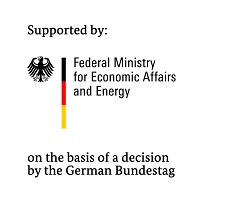
The project is one of about thirty projects funded within the funding program “International Showcase of Electric Mobility (Berlin-Brandenburg)” and was funded by the Federal Ministry for Economic Affairs and Energy as part of the Showcase program of the Federal Government. In April 2012, the Federal Government selected four regions in Germany as “Showcase Regions for Electric Mobility”, and by a decision of the German Bundestag funded the research and development of alternative propulsion in these regions. In total, the Federal Government provided 180 million euros for the Showcase program. Within the large-scale regional demonstration and pilot projects, electric mobility was tested at the intersection of energy system, vehicles, and transport system.
The International Showcase of Electric Mobility Berlin-Brandenburg was funded by the Federal Government and the States of Berlin and Brandenburg for the duration of three years as part of the Showcase program of the Federal Government. The project was coordinated by the Berlin Agency for Electromobility eMO.
Funding amount: 742,828 €
Research at RLI is supported by the Reiner Lemoine Foundation.
Evolutionary Multi-Objective Optimization of Micro Grids | A. Wanitschke | Poster
Cost-self-sufficiency-tradeoff in a real-life urban microgrid with electric vehicles | A. Wanitschke et al.
Multi-objective optimization of an autobahn EV charging station supplied by renewable energy | A. Wanitschke et al. | Paper
Populationsbasierte Optimierungsmethoden zur Entscheidungsunterstützung im Energiesystemdesign: Diskussion einiger Ansätze | A. Wanitschke et al. | Paper
An approach for the simulation and control of microgrids under consideration of various energy forms and mass flows | Grüger et al. | Poster
Model-based Quantification of a Microgrid using Key Performance Indicators | F. Möhrke et al. | Poster
Thermal pre-conditioning of electric vehicles for range extension | J. Nerling et al. | Paper
Cost-self-sufficiency-tradeoff in a real-life urban microgrid with electric vehicles | A. Wanitschke et al.
Multi-objective optimization of an autobahn EV charging station supplied by renewable energy | A. Wanitschke et al. | Paper
Populationsbasierte Optimierungsmethoden zur Entscheidungsunterstützung im Energiesystemdesign: Diskussion einiger Ansätze | A. Wanitschke et al. | Paper
An approach for the simulation and control of microgrids under consideration of various energy forms and mass flows | Grüger et al. | Poster
Model-based Quantification of a Microgrid using Key Performance Indicators | F. Möhrke et al. | Poster
Thermal pre-conditioning of electric vehicles for range extension | J. Nerling et al. | Paper



